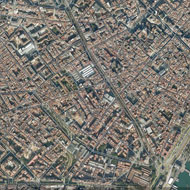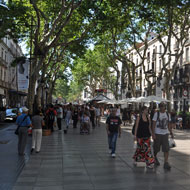Background
Las Ramblas is a .75-mile long, tree-lined pedestrian mall in Barcelona's Gothic Quarter. The wide boulevard begins at the city's main square, Plaza Catalunya, and ends at the Christopher Columbus monument at Port Vell.
The Ramblas consists of five pedestrian-oriented streets: Rambla de Canaletes, RambladelsEstudis (or RambladelsOcells), Rambla de SantJosep (or Rambla de les Flors), RambladelsCaputxins, and Rambla de Santa Mònica.
In the medieval era, Las Ramblas was a riverbed just outside of the city walls. By the 15th century, the city had expanded across the river, changing the characteristics of Ramblas. In 1856, the remnants of the old city wall were torn down. The central pedestrian promenade of Las Ramblas has remained the same since.
The Ramblas used to be the space where everyone could stroll and spend their leisure time. Because of its central location, the Ramblas became a meeting place for all the social classes and is now a tourist attraction. Las Ramblas is a boulevard with a 36- to 80-foot wide pedestrian strip down the middle. Sidewalks are usually less than 10 feet wide, encouraging walking in the center. On each side of the strip, there are one or two lanes of traffic with a lane for parking and deliveries. This reserves the center of the street for pedestrians and the side traffic lanes for autos, reversing the usual relationship between pedestrians and vehicles.
The street width, building height and landscaping work together to create a pedestrian-friendly environment. The street is lined by five- to seven-story buildings with complex facades, textures and ornamental details. There are many entrances–almost every 13 feet–and windows create a sense of transparency to view of what is inside (Jacobs 1995). Large London plane trees, spaced less than 20 feet apart, create an interweaving canopy. The canopy filters light in the hot summer and also gives protection from the one-way traffic on either side. The building heights permit sun on the central promenade during the winter.
The central promenade is usually full of retail pushcarts, sales kiosks, and arts and crafts exhibitions. There are ample sitting areas. Some of the paving was decorated by the artist Joan Miró. There are several interesting destinations along and adjacent to the street, such as La Boqueria (the city's largest market), Plaza Reial, museums and a theater. Moreover, the street has its own program of events by permitting performances by local artists and musicians. Its visual and cultural landscape is different with every visit.
Adopted from: Jacobs 1995; Jimenez, A. et al.
Lessons Learned
Potential Benefits:
- Comfort and Image
- The pedestrian-prioritized street and the harmony between street width, building height, landscaping and intensity of usage create a pleasant pedestrian experience.
- A mix of activities promotes diverse images and characters of the area.
- Uses and Activities
- Pedestrian promenade and sitting area for people-watching, discussions, and entertainment.
- Retail and market space, including restaurants, eateries, and bars.
- Exhibition space, festivals, bazaars, and demonstrations.
- Cultural institutions, museums, and monuments (Columbus statue, Canaletas fountain).
- Access and Linkage
- Major thoroughfare connecting central city plazas with waterfront by way of Gothic quarter.
- Prioritized pedestrian access from central promenade.
- Walkable along entire length (less than one mile).
- Metro access.
Adopted from: Project for Public Spaces, 2003
Potential Issues
- Design consistency: Allan Jacobs noted in his book, Great Streets, that the newly installed street lights do not match the existing street lights and other facilities, disturbing the original characteristics of the street.
Sources
Alex-Ricardo Jimenez and Zhan Guo. “Case Study on Las Ramblas, under the direction of Thomas Piper of the Dept. of Urban Studies and Planning” (http://www.boston.com/beyond_bigdig/cases/barcelona/index.shtml)
Jacobs, Allan B., 1995. “Great Streets” MIT Press
Project for Public Spaces, 2003. (http://www.pps.org/great_public_spaces/one?public_place_id=59)
Photo Sources
MIG, Inc.


